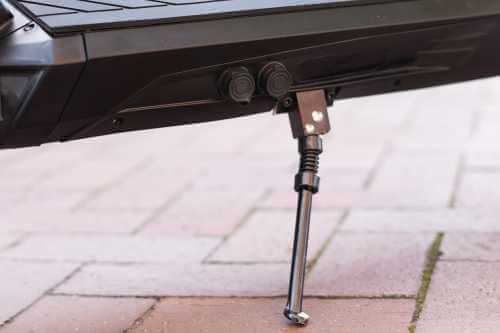Subscribe to our channel for more great videos.
Discover how the Canadian electric scooter brand Apollo designed the Phantom and what the ESG team thinks of the prototype
A New Design Based on Riders’ Feedback
Engineering an all-new model of an electric scooter is an arduous task, as so many scooters in the market are slight variations on the same design. Enter the Phantom, the first electric scooter fully designed by Apollo that directly addresses requested features based on feedback from thousands of riders, including the need for a rock solid stem, effective lighting, and intuitive display.

Our content is independent, but buying through our links may earn us a commission.
The 52V 23Ah Phantom is available for preorder now (with significant early adoption discounts). With regular disc brakes, the Phantom is $2,099 USD, but you’ll it for $1799 during preorder. The Phantom with hydraulic brakes will usually set you back $2249 USD, but is currently $1949. Both Phantoms come with a premium tool kit, more on that later.

Already impressed, Chuck has stated that the Phantom is “a standout scooter of 2021.” Ramier loves how it handles at speed, since he was already ripping down the streets when he first jumped on. Out of all the scooters she’s ridden, Trina feels like it’s the closest that an electric scooter has come to an actual vehicle, and could see it replacing a car for some commuters, but the data-based verdict’s not quite out yet.
The Phantom’s HEX Display Is on Point
The first thing we noticed about the Phantom is the enormous, gorgeous LCD dashboard. The proprietary HEX display is 3-½ in at its widest point with a unique hexagonal shape, while the round QS-S4 and EY3 LCD displays measure 1-¾ in diameter. It’s smart and attractive, and the perfect centerpiece for a scooter meant for daily commuting.

Not only is it supersized in dimensions, it’s also got super intelligent functionality, providing on-screen indicators for everything that a rider needs to know. The most impressive feature of the HEX display is its ability to predict remaining mileage. It’s not based on battery charge; it’s an actual estimation based on how you’re throttling, and that’s a spectacular innovation. Range anxiety could be a thing of the past, if other scooter manufacturers can keep up with this tech.
The Stem Folding Mechanism Is Stellar
Past models of Apollo scooters, except for the most recent Apollo Ghost, have all had some degree of stem wobble or creak out of the box, but the Phantom’s stem is rock solid, even without all three of the safety mechanisms they’ve designed in place (not that you should ride without them).

The release-hook style stem folding mechanism has a rotating collar that ensures the hook stays secure against the stem when locked into place. The folding mechanism and stem are welded together, making it feel very robust, solid, and high quality. It was also really easy and intuitive to release and engage the hook when folding the scooter down. No more futzing with screws and clamps on the Phantom!
In addition, the Phantom’s mechanism also features a release pin that you thread through the stem, for ultra safety, much like the Wolf Warrior. The pin does not have a chain leashing it to the scooter, but we don’t think it’s likely you’ll lose it as it fits snuggly in its hole.
Real Turn Signals with On-Screen Indicators
Most electric scooters don’t feature turn signals, and when they do there are usually some flaws.

The Phantom’s lighting package is pretty close to perfect. It comes with a high-mounted 1000 lumen headlight complemented by deck headlights, orange hued rear turn signals, and a brake light on the footrest. The only thing you might miss is some swag lighting under the deck (we were hoping for some). We tested the brightness of the turn signals in the daylight, and they were bright and easy to see.

You use the same button console to control the headlights and turn signals, and whenever your lights are engaged you’ll find a matching on-screen indicator on the HEX display. It’s an excellent reminder and such a user-friendly feature, and we’re happy to see Apollo took their riders’ feedback this deep.
The only downside to the lighting configuration is that the turn signals are only on the rear, meaning drivers facing you won’t know if you’re turning against them in traffic. In future models, we suggest switching the front deck lights to turn signals (and add some under-deck lighting for funsies).
Building a Better Scooter From the Tires Up
In a recent video, Eloi Pecquet, CTO and Product Manager at Apollo Scooters, explains that the Phantom has already gone through three major evolutions in-house before the final model arrived in the ESG Lab this week.
Motivated to create an all-around excellent riding experience, the Apollo Scooters team experimented with tubeless tires, tested different motor styles and component fixtures, and fine tuned how the fenders, suspension, footrest, folding hook, and stem steering head all come together in the Phantom. Check in with Eloi in the video above for the full deets.
Combined with the quad spring suspension and dual hydraulic brakes, the Phantom has so many marquee features of a standout high performance scooter that we’re not exactly sure what to compare it to, but we’re eager to see how it stacks up when it comes to performance.

How Apollo Designed the Phantom for Repairability
Probably the most rider-focused thing about the Phantom is its repairability. Apollo has used plug-and-play components for as many electronics as possible in the cockpit, so riders can replace anything that malfunctions, including the HEX display.
Although this may seem like a very small feature, this allows you to replace the keystart ignition, thumb throttle, brake sensors, and button consoles, meaning the Phantom will have a longer lifespan than other scooters where plug-and-play connectors are not used. The cables are exposed around the display which isn’t the cleanest look, but easy access to the cables is convenient.

Apollo also went from tubeless tires to inner tube tires on split rims, so that they’re the easiest to change when riders get a flat (and provide superior ride quality, according to Apollo). They also ensured the kickstand is attached via a bracket, rather than screwed directly into the scooter deck, so if it gets sheared off it can easily be replaced. The placement of the kickstand bracket also protects against the charging ports getting damaged, should the scooter fall. Ingenious, no?

Lastly, the Phantom comes with a premium tool kit, featuring two inner tubes, two sets of brake pads, eight allen keys for all screws, allen key bits to fit with a screw ratchet driver, air pump, and air valve extender. The tool kit is a zippered and reinforced case, which is pretty convenient to pop in your scooter go-bag.
Putting the Phantom Through the Paces
Don’t miss Chuck and Ramier’s first impressions of riding the Phantom (video at the top!). You can also check out Julian from Fluid Freeride just above, mobbing on- and off-road around Florida.
Our comprehensive review of the Phantom will be released soon, so continue to follow us here and on social for the latest in electric scooter news.
The Phantom is available in Canada (exclusively from Apollo) and the United States (exclusively from Fluid Freeride).
Our content is independent, but buying through our links may earn us a commission.



